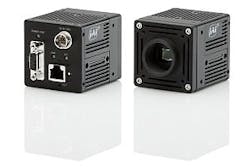The AM-201GE (monochrome) and AB-201GE (color) industrial-grade CCD cameras provide 1920 × 1080 pixel resolution at 38.3 frame/s for 8-bit monochrome or raw Bayer color output. The AM-200GE (monochrome) and AB-200GE (color) provide 1600 × 1200 pixel resolution at 40.6 frames/s in a 4:3 aspect ratio. All use a single GigE Vision interface.
JAI
San Jose, CA
[email protected]
More Products
-----
PRESS RELEASE
Four new 2-megapixel cameras with GigE Vision interfaces
SAN JOSE, CA — February 8, 2012 — JAI has added four new GigE Vision cameras to its series of industrial grade CCD cameras built around quad-tap sensors from Kodak.
The new AM-201GE (monochrome) and AB-201GE (color) are built around the Kodak KAI-02150 quad-tap sensor, providing 1920 x 1080 resolution at 38.3 frames per second for 8-bit monochrome or raw Bayer color output. The color model (AB-201GE) can also perform in-camera color interpolation to provide YUV 4:2:2 packed color output at 26.6 fps, or 24-bit RGB output (8-bits per color) at 17.7 fps.
For customers wanting a traditional 4:3 aspect ratio, the new AM-200GE (monochrome) and AB-200GE (color) provide 1600 x 1200 resolution at 40.6 frames per second for 8-bit monochrome or raw Bayer color output. These cameras are built around the Kodak KAI-02050 quad-tap sensor. The color model (AB-200GE) can perform in-camera color interpolation to provide YUV 4:2:2 packed color output at 28.8 fps, or 24-bit RGB output (8-bits per color) at 19.2 fps.
10-bit and 12-bit output is also selectable on all four cameras
The new models feature a single GigE Vision interface, providing simple setup and low cost cabling and networking options. JAI's free SDK and Control Tool software provides easy access to the camera's extensive feature set, as well as a wide range of library functions and samples for quick application development. GigE Vision / GenICam-compliant software tools and libraries from third-party companies are also supported.
The cameras feature an advanced channel balancing function which continuously adjusts the video levels coming from the multi-tap sensor to ensure uniformity across the image. User configurable AOI scanning (partial scanning), multiple binning modes (monochrome only), and a variety of acquisition modes are supported, including continuous, single-frame, and multi-frame capture. The cameras are equipped with an Automatic Level Control (ALC) capability that integrates auto-shutter, auto-gain, and auto-iris features for maximum exposure control under changing lighting conditions. Image pre-processing features include auto-white balancing, pixel blemish compensation, flat-field compensation, and a 512-point look-up table for gamma customization.
The cameras have C-mount lens mounts. Dimensions are 55 mm wide and 55 mm high by 69 mm in length.
About the JAI Group
JAI is a manufacturer of high quality, industrial-grade cameras for the machine vision, transportation, aerospace, homeland security, medical and scientific markets.
JAI’s broad product line features high performance progressive scan CCD cameras with spatial resolutions from VGA to 16 megapixels; traditional interlaced video cameras; intensified cameras with sensitivity to light levels as low as .00001 lux, and a range of innovative 2CCD and 3CCD prism-block cameras including both area scan and line scan models.
Physical interfaces include the Camera Link® and GigE Vision® high performance digital standards, as well as both TV-standard and analog progressive scan output.
JAI cameras help improve customer businesses in a variety of ways, whether by improving quality and accuracy, lowering costs, increasing yields, or simply enabling better service. In addition to cameras, JAI’s traffic solutions group is one of the world’s leading manufacturers of specialized traffic systems. Solutions are based on JAI-developed hardware and software, which is often integrated with third-party products.
-----
Follow us on Twitter
Follow OptoIQ on your iPhone; download the free app here.
Subscribe now to Laser Focus World magazine; it's free!
Sponsored Recommendations
Sponsored Recommendations
Request a free Micro 3D Printed sample part
April 11, 2024
How to Tune Servo Systems: The Basics
April 10, 2024
Voice your opinion!
Voice your opinion!
